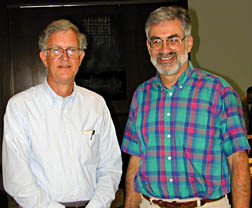 Stephen Baker (left) and Stephen Holt |
To any observer at the November Council meeting in Seattle, it would appear obvious why a motion to amend the APS Constitution to reduce the size of the Council passed overwhelmingly. Sixty-three people gathered around a hollow rectangle, which was so large that it was difficult to see from one side to the other. "We strongly believe that the most important action that can be taken to make the APS Council more effective is to reduce its size to the point that its members feel that they can be seen, that their views can be heard, and that their presence can make a real difference," said Stephen Holt (NASA/GSFC), the member of the APS Task Force on the Structure and Responsibilities of the Council who presented the draft recommendations to Council. The Task Force, chaired by Ernest Henley (University of Washington) recommended that the number of voting members be reduced from 51 to 39 and the number at the Council table from approximately 65 to 42.
The drafting of changes to the APS Constitution and Bylaws needed to implement the Task Force recommendations were carried out by the Committee on Constitution and Bylaws, chaired in 1999 by Stephan Baker (Rice University). The relevant sections of the sections with the proposed changes can be found online, and are presented for comment by the APS membership at large. To become effective the Constitutional amendments must be voted on by the APS membership, while the amendments to the Bylaws require a second Council vote.
The last major revision to the APS Constitution in 1990 established a representational scheme based on X, a percentage of the total APS membership (currently, X = 3). X was used to determine the number of councillors from divisions (with larger divisions having more); while forums would gain a Councilor, topical groups could become divisions, and geographical sections were entitled to a Council advisor once their membership percentage exceeded X. X also determined the number of General Councillors, currently 16, in an indirect way.
The task force presented an interim report to Council at its May 1999 meeting (see APS News, August/September 1999), recommending that the role of X be reduced and limiting divisions to one councilor each (14) and reducing the number of general councilors from 16 to 9. In addition the threshold for forums to have Council representation was increased from X to 2X. Currently this will have no effect on the number of Forum Councillors. There was strong Council support for reducing its own size. However the Council asked the Task Force to consider replacing the 5 Section Advisors with 2 voting Section Councillors, which the Task Force decided to do, and to reconsider the role of the General Councillors.
The task force declined to lower the number of general councillors further than to 8, since they often provide balance and diversity to the Council through the election of women, minorities, younger physicists, and physicists employed in industry. One International Councillor with a 2-year term was added to the Council. The rationale for this, according to Holt, is that foreign members currently have no direct representation on Council and have difficulty winning election when running against US physicists. Two-year terms were deemed preferable to the usual four-year terms to alleviate the extra burden of travel for non-US physicists to attend Council meetings. To make the Council table significantly smaller, the Task Force recommended that only a very limited number of non-voting Council Advisors be asked to sit at the main table. Other Council advisors would sit at additional tables close by.
©1995 - 2024, AMERICAN PHYSICAL SOCIETY
APS encourages the redistribution of the materials included in this newspaper provided that attribution to the source is noted and the materials are not truncated or changed.
Editor: Barrett H. Ripin
Associate Editor: Jennifer Ouellette
January 2000 (Volume 9, Number 1)
Articles in this Issue

